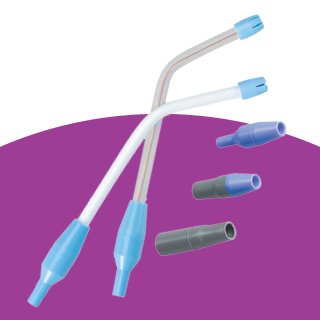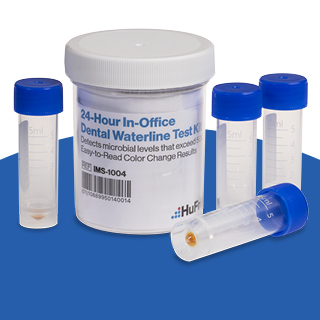Blog
Dental Infection Prevention Month: Identifying Chairside Infection Risks

Guide to Minimizing Infection Risks in Dental Practices
It’s Dental Infection Control Awareness Month (DICAM), and there’s no better time than now to brush up on ways to support patient safety in the dental chair. That means shining a light on what you and your team need to know to protect yourselves and your patients, starting with a refresher on infection risks.
Chairside Risks Reminder
As much as you want to trust your patients to share when they’re not feeling well, they may not know that they’re potentially putting you and your next patient at risk of infection. At any time, patients can have an underlying condition that poses infection risk, including:
- Hepatitis B, C, and HIV
- Streptococcus
- Staphylococcus and MRSA
- Herpes, CMV, Norovirus, and C diff
- Coxsackie
- Respiratory viruses
- Influenza, RSV, SARS, and MERS
- SARS-CoV-2
- Measles, Chickenpox, and Tuberculosis

The fact that patients can unknowingly transmit any of these directly to dental professionals underscores the importance of standard precautions.
The Centers for Disease Control and Prevention (CDC) states that “Standard Precautions are the minimum infection prevention practices that apply to all patient care, regardless of suspected or confirmed infection status of the patient, in any setting where health care is delivered.”
The CDC specifies Standard Precautions in a variety of areas, such as:
- Hand hygiene
- Use of personal protective equipment (e.g., gloves, masks, eyewear)
- Respiratory hygiene and cough etiquette
- Safe injection practices (i.e., aseptic technique for parenteral medications)
- Clean and disinfected environmental surfaces
It’s particularly important to prevent cross-contamination by following dental office protocols before, during, and after the patient visit.
Pre-Visit Preparation Can Prevent Cross-Contamination
Infection prevention starts before the patient enters the room. Make sure your team surveys the operatory to confirm that it is neat and organized. Dental professionals should inspect instruments to ensure they are intact and not compromised. For example, the packaging should be dry and sealed properly, with no holes or tears from the sharp instruments. All instruments and tools remain packaged or protected until the patient presents for treatment.
Preventing Infection Risk During Exams and Procedures
During procedures, dental professionals can be exposed to infection when saliva travels to the face shield, instruments, the keyboard, the dental chair, and other parts of the operatory. This makes it imperative to use operatory infection prevention supplies that help protect against invisible hazards, such as aerosols.
Disinfect Metal Bib Chains
Studies have shown that dental bib clips and chains have been shown to pick up dangerous microorganisms from skin, saliva, and plaque, presenting a potential source of cross-contamination in the dental operatory. Your team should either use disposable bib clips or wipe bib chains with an EPA-approved, intermediate-level disinfectant between patient appointments to reduce microbial load.
Sani-Tab is the only chain-free patient towel with adhesive tabs, eliminates the need for bib chains and clips and maximizes infection control and patient comfort while saving time and money.
Practice Eye Safety
Dental professionals are especially susceptible to occupational eye hazards. The American Academy of Ophthalmology has found that 90% of the 2,000 daily on-the-job eye injuries can be avoided with the right eye protection.
Dental offices are also expected to comply with the various guidelines for eye personal protective equipment set forth by Occupational Safety and Health Administration (OSHA) standards and the CDC.
HuFriedyGroup offers a line of safety eyewear for dental professionals and patients from Palmero Healthcare that meet industry standards and guidelines for lens, cornea, and retina protection. They provide excellent optics for visual acuity, and they come in a broad range of frame, temple, and nose bridge styles.
- The ProVision® collection consists of wraparound safety glasses, goggles, bonding, laser, magnification, and bifocals, including pediatric patient styles.
- Dynamic Disposables® Safety Eyewear are lightweight, disposable, cost-effective lenses featuring self-closing holes to prevent gaps and meet OSHA’s and CDC’s guidelines for protective eyewear. Clear, grey, and bonding lenses fit onto a reusable frame, wrapping around the head and providing protection from the top down against splash and splatter contamination incidents.
- Dynamic Disposables® Snapeez™ face shields in half- and full-face sizes are self-sealing face shields that prevent exposure to bloodborne pathogens.
Protecting patients from backflow is equally important.
Leverage Proper Saliva Ejector Placement and Products
A recent poll of dental professionals found that more than 50% are not using or are unaware of what a backflow device is, and over 34% report that their dental practices don’t use backflow devices during patient treatment. This can also put patients at risk for infection and cross-contamination.
In fact, a CDC study found that dental personnel are ranked among the highest risk occupations for exposure to SARS-CoV-2 due to their close proximity to the patient’s mouth and many aerosol generating procedures encountered in dental practice. One method to reduce aerosols in dental settings is the use of intraoral evacuation systems.
What Is Backflow?
Backflow happens when fluids from the evacuation line flow back into a patient's mouth. Studies show that backflow can occur 21% of the time (1 out of every 5 patients). As a result, the CDC recommends that “dental health care personnel should not advise patients to close their lips tightly around the tip of the saliva ejector to evacuate oral fluids.”

How to Prevent Backflow
There are a number of ways to prevent backflow:
- Remind patients not to close their mouths around the saliva ejector.
- Hold the evacuation line parallel to the patient’s mouth instead of above their mouth.
- Choose products that prevent changes in vacuum pressure.
Safe-Flo™ Saliva Ejectors and Valves from HuFriedyGroup are specifically designed to stop backflow and protect patients by preventing potential cross-contamination risk. These single-use disposable saliva ejectors and valves (compatible with properly maintained saliva ejector screens) prevent backflow while eliminating the chore of dismantling/disinfecting valves and ensure patient safety.
- The Safe-Flo™ Saliva Ejector is a fully assembled, all-in-one saliva ejector with an attached Safe-Flo Valve.
- The Safe-Flo™ SE Valve is a backflow valve that can be used with your preferred saliva ejector brand.
- The Safe-Flo™ HV Valve prevents backflow and can be used with your favorite brand of HVE tips to prevent backflow in HVE lines.
- The Safe-Flo™ Adapter provides backflow prevention and allows users the ability to use their preferred brand of saliva ejectors on an HVE line, providing the saliva ejector with a higher level of aspiration.
Dental professionals also need to be aware of waterline maintenance guidelines, which are specifically developed to prevent infection.
Adhere to Waterline Maintenance Guidelines
Both the CDC and the American Dental Association (ADA) are clear that water in all DUWLs should demonstrate less than or equal to 500 colony-forming units of bacteria per milliliter (CFU/mL). Dental professionals must regularly practice waterline maintenance protocols to include preparation, implementation, and continuation measures.
Preparation
Based on guidance provided by the equipment manufacturer, the DUWL treatment manufacturer, or OSAP guidance, set a regular testing interval. Make sure that dental office staff has researched and selected the right products.

Implementation
Test DUWLs to ensure that counts meet the current potable water standard (≤500 CFU/mL). HuFriedyGroup offers three options for dental offices to choose from:
- In-Office Paddle Testing, which offers pass/fail results to determine if an operatory should be closed for waterline treatment.
- Mail-In Lab Testing, which offers the most precise test results but requires a longer wait time.
- 24-Hour In-Office Waterline Testing, which is a considerably more accurate in-office waterline test and can lead to the faster opening of an operatory.
Shock failed waterlines to quickly bring down high CFU levels and utilize a waterline maintenance treatment on all DUWLs to increase safety.
Continuation
Always document maintenance, test results, remediation, and training in a log. Make sure that dental office staff who are responsible for waterline testing and treatment continue to receive training on protocols using a set schedule.
Post-Procedure Infection Prevention
After a patient visit, the operatory must be properly cleaned and disinfected, including wiping down all surfaces.
Disinfect Surfaces Regularly
Use hospital-grade, EPA-registered disinfectants that are effective against viruses, bacterium, and fungi. These products should meet a minimum number of qualifications, including:
- Environmental Protection Agency (EPA) registration number
- Identified as a Tuberculocidal disinfectant
- Usable on a range of surfaces and in several conditions
- Has cleaning and disinfecting properties
- Has low allergenicity
- Has clear, easy-to-follow IFUs
- Requires a reasonable contact time
HuFriedyGroup offers two surface disinfectant products: AdvantaClear™ and DisCide® ULTRA. Both are designed to clean and disinfect dental surfaces while working extremely fast and effectively to kill a broad spectrum of disease-causing microorganisms, including Tuberculosis.
They clean and disinfect and are available in wipes and ready-to-use liquids. DisCide ULTRA has a contact time of one minute, while AdvantaClear™ has a contact time of two minutes for Tuberculosis. The products are compatible with multiple surfaces, including aluminum, brass, copper, stainless steel, chrome, and most plastics.
All instruments must be properly cleaned and disinfected after each patient visit as well.
Practice Proper Instrument Cleaning and Reprocessing
Ensure that your team follows best practices for instrument cleaning and reprocessing, which involves the following steps:
Presoak Instruments That Can’t Be Immediately Cleaned
While it’s not always possible to clean instruments immediately after use, biological debris can dry, harden, and become quite difficult to remove. Industry experts recommend spraying or soaking soiled instruments with a solution to keep organic buildup moist until the instruments can be cleaned properly.
Enzymax® Enzymatic Detergent from HuFriedyGroup is a dual enzyme ultrasonic cleaner that removes bioburden from dental instruments and can be used to soak and pretreat instruments prior to cleaning. The protease enzyme in Enzymax® eats the proteinaceous material on dental instruments.
Use Cassettes for Safety and Efficiency
Instead of keeping instruments loose in containers for presoaking and cleaning, consider utilizing secure cassettes to reduce the risk of injuries and instrument damage and create an optimal environment for reprocessing,
By using cassettes, dental professionals can avoid handling contaminated instruments any longer than necessary. And because cassettes can be configured according to procedure, instruments are kept secure throughout the entire cycle, from patient use, to presoak, to cleaning, and all the way through to reprocessing.
There are a number of advantages to using cassettes:
- Cassette rails keep instruments separated during reprocessing, allowing access to instruments during cleaning and sterilization while protecting them from scratching and breaking.
- Cassettes prevent instruments from sliding out or falling off of instrument trays during transportation. Even if a cassette is dropped, the instruments stay safe.
- Cassettes can be placed directly into presoaking containers and ultrasonic cleaners. And they can be rinsed, dried, wrapped, and sterilized without removing instruments.
- Cassettes help prevent overloading cleaning and sterilization equipment.
The cassette-based Instrument Management System (IMS) from HuFriedyGroup has proven to be highly effective for dental practices, who report that they also save dental professionals 5 to 10 minutes per procedure.
To take a deeper dive into protecting patients and preventing infection risks, this informative webinar titled “Identifying Invisible Chairside Infection Control Risks,” led by Doug Risk, DDS, and Karen Gregory, RN, CDIPC, is available for viewing. Participants are also eligible to earn CEUs.
To learn more about products to help prevent infection and protect patients and staff, visit HuFriedyGroup.com.

